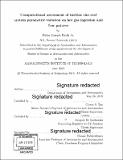Computational assessment of turbine rim seal system parametric variation on hot gas ingestion and flow pattern
Author(s)
Rock, Peter Joseph, Jr
DownloadFull printable version (16.26Mb)
Other Contributors
Massachusetts Institute of Technology. Department of Aeronautics and Astronautics.
Advisor
Choon S. Tan and Gregory M. Laskowski.
Terms of use
Metadata
Show full item recordAbstract
A design of experiments (DOE) is carried out to assess the turbine rim cavity system parametric variation on hot gas ingestion, flow pattern, and turbine stage efficiency. The parameters focused on are purge to main mass flow rate ratio, axial gap to rim radius ratio, radial gap to rim radius ratio, normalized axial position of the blade leading edge, and internal purge cavity radius ratios. The results were used to formulate a non-dimensional sealing parameter, [psi], that has a threshold value of [psi] = 2.3 - 10¹⁵, beyond which there is only a marginal variation in ingestion penetration depth. This non-dimensional sealing parameter is given as a function of rim seal geometry, purge mass flow rate ratio, Rotational Reynolds number, purge flow Reynolds number, rim seal Reynolds number, and Rossby number. The non-dimensional sealing parameter reflects the physical effects associated with rim seal geometry, flow characteristics, and operating parameters. The computed flow field demonstrates the dominant role of vortical structures in the rim cavity flow on effective flow area distribution and hence the ingestion penetration depth. Quantitative attributes of the vortex, such as non-dimensional circulation, maximum vorticity, height to width ratio, and normalized vortex center position, scale with the non-dimensional sealing parameter. As a result, the vortex attributes scale with ingestion penetration depth. The implication is that the sealing parameter potentially provides a guideline for selecting rim seal configurations and operating space to yield marginal levels of hot gas ingestion. The variation in turbine stage efficiency is approximately linear with purge mass flow rate ratio, where a decrease of 0.7% in efficiency is observed for every 1% increase in purge mass flow rate ratio. This result is in accord with published results to-date.
Description
Thesis: S.M., Massachusetts Institute of Technology, Department of Aeronautics and Astronautics, 2018. Cataloged from PDF version of thesis. Includes bibliographical references (pages 125-127).
Date issued
2018Department
Massachusetts Institute of Technology. Department of Aeronautics and AstronauticsPublisher
Massachusetts Institute of Technology
Keywords
Aeronautics and Astronautics.